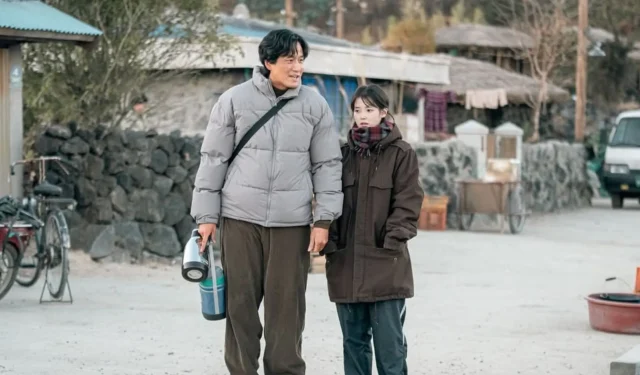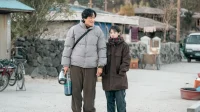On April 3, 2025, Onmanorama reported an intriguing development surrounding the Netflix series When Life Gives You Tangerines. This show has sparked a culinary renaissance among its audience, with many netizens sharing their experiences of cooking rice with peas, inspired by a pivotal scene from the series.
In a memorable moment, the character Ae-sun prepares a modest meal of rice mixed with peas. This dish serves not only as a staple for families struggling financially but also highlights the era’s economic challenges. During tough times, families often mixed rice with legumes or peas to create more filling meals, ensuring that nutrition was not compromised.
As depicted in the series, Ae-sun’s preparation of rice with peas carries deeper implications; despite her hard work, both she and her daughter are denied the chance to enjoy this comforting meal. Traditionally, such dishes would be served primarily to the male members of the household, specifically Ae-sun’s husband, Gwan-sik, and his father.
Interestingly, Gwan-sik and their daughter Geum-myeong both share a fondness for peas. In episode 4, Gwan-sik’s act of passing the peas from his rice bowl to Geum-myeong is a poignant moment that signifies a break from traditional norms. By breaking bread at the same table as his wife and daughter, he embodies a shift in socioeconomic and cultural attitudes.
This shift has had a tangible impact in the culinary realm as food bloggers and fans have taken to platforms like Instagram and X to document their attempts at recreating the rice and peas dish. Interestingly, this dish has cultural parallels in Japan, where it is known as Mame Gohan (Green Pea Rice), typically prepared with “dashi”broth to enrich its flavor.
As reported by Korea Economic Daily, the cultural significance of the rice and peas dish has resonated throughout South Korea. Historically, in the 1950s, societal norms dictated that men, often considered more valuable due to their scarcity, enjoyed exclusive rights to certain delicacies like croaker fish and peas during meals. This historical context makes the representation of food in When Life Gives You Tangerines all the more poignant.
Following the airing of the series, there has been a noticeable transformation in high school cafeterias across South Korea. The program recently cited that these cafeterias began offering a meal set featuring fried croaker fish, steamed cabbage, squid soup, rice with peas, and kimchi, under the initiative dubbed Bokssak Sokkaessuda.
Additionally, convenience stores have embraced the show’s popularity by displaying Gwan-sik’s cabbage-related dialogue prominently in their produce aisles, further blurring the lines between entertainment and everyday life.
Bittersweet Farewell: When Life Gives You Tangerines Concludes with Poignant Finale
The series’ essence is encapsulated in its title, When Life Gives You Tangerines, translating to “Pokssak Sogatsuda”in the Jeju dialect—an expression of appreciation for hard work. This reflection upon Jeju’s cultural fabric not only connects viewers to the land but also offers a narrative arc filled with resilience and gratitude.
Tangerines, a symbol reflecting Jeju Island’s identity as Korea’s citrus capital, serve as a metaphor for the characters’ journeys—sweet yet often tinged with hardship. The series follows Oh Ae-sun, portrayed by IU, a spirited young woman in the 1960s dreamt of becoming a poet, while navigating societal expectations.
Interwoven in her journey is Yang Gwan-sik, played by Park Bo-gum, whose unwavering love for Ae-sun faces tests from family opposition, financial woes, and political changes in Korea. The narrative reaches its emotional zenith when Gwan-sik, portrayed by Park Hae-joon in his later years, confronts a terminal illness, opting to spend his last days surrounded by family on Jeju Island.
His passing is depicted with a sense of poise, underscoring his lifelong commitment to Ae-sun and their children, leading to a profound exploration of love and loss.
Following Gwan-sik’s death, Ae-sun, now played by Moon So-ri, embarks on a path of self-discovery and fulfillment. She begins writing poetry—a lifelong aspiration suppressed by the demands of motherhood and life’s responsibilities.
Throughout the series, particularly in episode 16, Ae-sun’s writing emerges as both therapeutic and a bridge to connect with others, especially the elderly whom she teaches to read and write. The narrative further explores the lives of Ae-sun and Gwan-sik’s children, particularly Geum-myeong, who rises as a successful technology entrepreneur, symbolizing the intersection of modern innovation and enduring traditions.
The finale woven with recurring symbols resonates deeply with audiences, employing imagery of Jeju’s stunning landscapes, various cultural artifacts, and the personal experiences of the characters against a backdrop of historical significance. When Life Gives You Tangerines not only chronicles the evolution of a family but also reflects the rapid industrialization, shifts in women’s roles, and the lasting influence of tradition in contemporary Korea.
Ae-sun’s mother appears as a haenyeo, emblematic of Jeju’s famous female divers, representing the crucial role women have played in their communities. Starring notable actors such as IU, Park Bo-gum, Moon So-ri, and Park Hae-joon, with special appearances by Kim Seon-ho, Lee Jun-young, and Kim Dae-young, When Life Gives You Tangerines elegantly intertwines personal stories with broader societal narratives.


